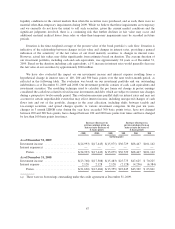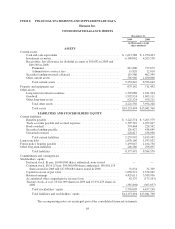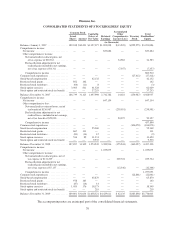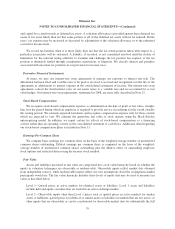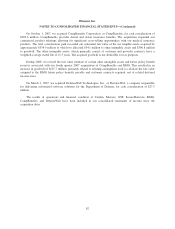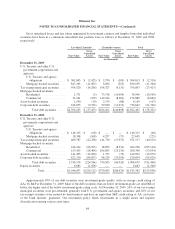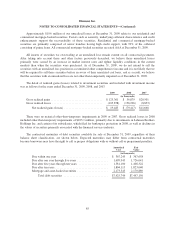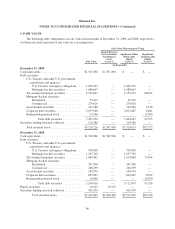Humana 2009 Annual Report Download - page 87
Download and view the complete annual report
Please find page 87 of the 2009 Humana annual report below. You can navigate through the pages in the report by either clicking on the pages listed below, or by using the keyword search tool below to find specific information within the annual report.Humana Inc.
NOTES TO CONSOLIDATED FINANCIAL STATEMENTS—(Continued)
Long-Lived Assets
Property and equipment is recorded at cost. Gains and losses on sales or disposals of property and
equipment are included in administrative expense. Certain costs related to the development or purchase of
internal-use software are capitalized. Depreciation is computed using the straight-line method over estimated
useful lives ranging from 3 to 10 years for equipment, 3 to 7 years for computer software, and 20 to 40 years for
buildings. Improvements to leased facilities are depreciated over the shorter of the remaining lease term or the
anticipated life of the improvement.
We periodically review long-lived assets, including property and equipment and other intangible assets, for
impairment whenever adverse events or changes in circumstances indicate the carrying value of the asset may not
be recoverable. Losses are recognized for a long-lived asset to be held and used in our operations when the
undiscounted future cash flows expected to result from the use of the asset are less than its carrying value. We
recognize an impairment loss based on the excess of the carrying value over the fair value of the asset. A long-
lived asset held for sale is reported at the lower of the carrying amount or fair value less costs to sell.
Depreciation expense is not recognized on assets held for sale. Losses are recognized for a long-lived asset to be
abandoned when the asset ceases to be used. In addition, we periodically review the estimated lives of all long-
lived assets for reasonableness.
Goodwill and Other Intangible Assets
Goodwill represents the unamortized excess of cost over the fair value of the net tangible and other
intangible assets acquired. We are required to test at least annually for impairment at a level of reporting referred
to as the reporting unit, and more frequently if adverse events or changes in circumstances indicate that the asset
may be impaired. A reporting unit either is our operating segments or one level below the operating segments,
referred to as a component, which comprise our reportable Commercial and Government segments. A component
is considered a reporting unit if the component constitutes a business for which discrete financial information is
available that is regularly reviewed by management. We aggregate the components of an operating segment into
one reporting unit if they have similar economic characteristics. Goodwill is assigned to the reporting unit that is
expected to benefit from a specific acquisition.
We use a two-step process to review goodwill for impairment. The first step is a screen for potential
impairment, and the second step measures the amount of impairment, if any. Impairment tests are performed, at a
minimum, in the fourth quarter of each year supported by our long-range business plan and annual planning
process. Impairment tests completed for 2009, 2008 and 2007 did not result in an impairment loss.
Other intangible assets primarily relate to acquired customer contracts and are included with other long-term
assets in the consolidated balance sheets. Other intangible assets are amortized over the useful life, based upon
the pattern of future cash flows attributable to the asset. This sometimes results in an accelerated method of
amortization for customer contracts because the asset tends to dissipate at a more rapid rate in earlier periods.
Other than customer contracts, other intangible assets generally are amortized using the straight-line method. We
review other finite-lived intangible assets for impairment under our long-lived asset policy.
Benefits Payable and Benefit Expense Recognition
Benefit expenses include claim payments, capitation payments, pharmacy costs net of rebates, allocations of
certain centralized expenses and various other costs incurred to provide health insurance coverage to members, as
well as estimates of future payments to hospitals and others for medical care and other supplemental benefits
provided prior to the balance sheet date. Capitation payments represent monthly contractual fees disbursed to
77


